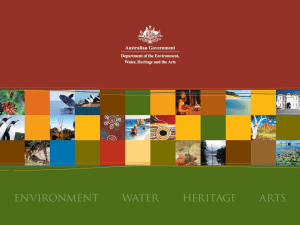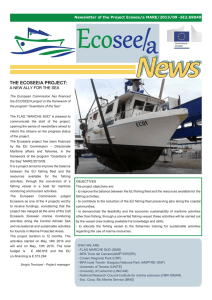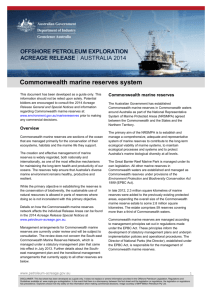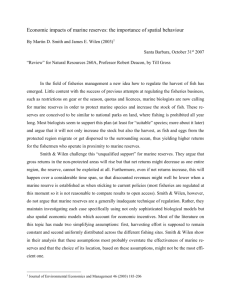Information for commercial fishers (DOCX
advertisement
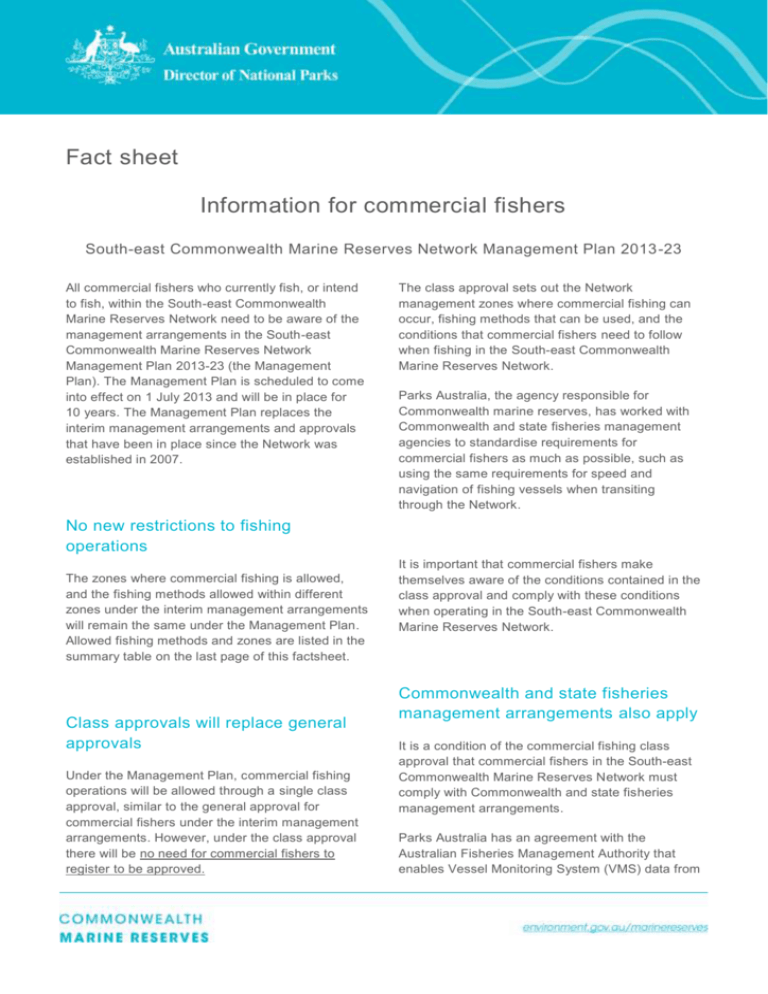
Fact sheet Information for commercial fishers South-east Commonwealth Marine Reserves Network Management Plan 2013 -23 All commercial fishers who currently fish, or intend to fish, within the South-east Commonwealth Marine Reserves Network need to be aware of the management arrangements in the South-east Commonwealth Marine Reserves Network Management Plan 2013-23 (the Management Plan). The Management Plan is scheduled to come into effect on 1 July 2013 and will be in place for 10 years. The Management Plan replaces the interim management arrangements and approvals that have been in place since the Network was established in 2007. The class approval sets out the Network management zones where commercial fishing can occur, fishing methods that can be used, and the conditions that commercial fishers need to follow when fishing in the South-east Commonwealth Marine Reserves Network. Parks Australia, the agency responsible for Commonwealth marine reserves, has worked with Commonwealth and state fisheries management agencies to standardise requirements for commercial fishers as much as possible, such as using the same requirements for speed and navigation of fishing vessels when transiting through the Network. No new restrictions to fishing operations The zones where commercial fishing is allowed, and the fishing methods allowed within different zones under the interim management arrangements will remain the same under the Management Plan. Allowed fishing methods and zones are listed in the summary table on the last page of this factsheet. Class approvals will replace general approvals Under the Management Plan, commercial fishing operations will be allowed through a single class approval, similar to the general approval for commercial fishers under the interim management arrangements. However, under the class approval there will be no need for commercial fishers to register to be approved. It is important that commercial fishers make themselves aware of the conditions contained in the class approval and comply with these conditions when operating in the South-east Commonwealth Marine Reserves Network. Commonwealth and state fisheries management arrangements also apply It is a condition of the commercial fishing class approval that commercial fishers in the South-east Commonwealth Marine Reserves Network must comply with Commonwealth and state fisheries management arrangements. Parks Australia has an agreement with the Australian Fisheries Management Authority that enables Vessel Monitoring System (VMS) data from Commonwealth fisheries operators to be shared. Fishers operating under state-managed fisheries may also be asked to provide their VMS details and data to Parks Australia. For all other fishing methods, gear must be stowed and secured (including recreational fishing gear) if transiting through zones they are not allowed to fish in, including the Sanctuary zone and Marine National Park zones. For commercial fishing operators, the Director of Overview of management arrangements for commercial fishing Demersal trawl, Danish-seine and scallop dredge fishing activities, as well as gillnetting below 183 metres, continue to be prohibited in the Southeast Commonwealth Marine Reserves Network. Commercial fishing operations are not allowed in: the Sanctuary zone of the Macquarie Island Commonwealth Marine Reserve; Marine National Park zones; the Recreational Use zone of the Freycinet Commonwealth Marine Reserve; and Special Purpose zones. Commercial fishing vessels may transit through all marine reserves and zones in the Network. Transit is allowed provided, where it is reasonable to do so, it is in a straight line and the vessel is travelling a minimum of 5 knots and does not stop for any reason other than in response to an emergency or to undertake an activity authorised by or under the Management Plan. Other conditions of transiting include: Demersal trawl, Danish-seine and scallop dredge vessels must have all fishing gear stowed and secured at all times in the Network. National Parks has determined that ‘stowed and secured’ means that all fishing equipment, including nets and lines, are not in contact with the water, and are onboard the vessel. Some changes to zone names The Management Plan changes the names and International Union for the Conservation of Nature (IUCN) categories of zones in some of the reserves in the South-east Commonwealth Marine Reserves Network. These changes establish a consistent approach to zone names, categories and identifying colours for all Commonwealth marine reserves around Australia. Importantly, none of the name and category changes alter the use or activities that have previously been allowed in these zones. The zone name changes are as follows: The Flinders, Freycinet, Murray and Tasman Fracture Commonwealth Marine Reserves Sanctuary zones (IUCN Category Ia) have changed to Marine National Park zones (IUCN Category II). The Huon Commonwealth Marine Reserve Benthic Sanctuary Zone (IUCN Category Ia) has changed to a Habitat Protection zone (IUCN Category IV). The Freycinet Commonwealth Marine Reserve Recreational Use Zone (IUCN Category II) has changed to a Recreational Use zone (IUCN Category IV). The Macquarie Island Commonwealth Marine The colours used to represent some zones have also changed as follows: Reserve Sanctuary Zone has changed from green to pink. The Huon Commonwealth Marine Reserve Benthic Sanctuary Zone has changed from pale green to yellow. Summary of management arrangements for commercial fishing operations in the South-east Commonwealth Marine Reserves Network Sanctuary Zone (IUCN Ia) Marine National Park Zone (IUCN II) Habitat Protection Zone (IUCN IV) Recreational Use Zone (IUCN IV) Special Purpose Zone (IUCN VI) Multiple Use Zone (IUCN VI) CA CA Demersal trawl Danish seine Scallop dredge Vessel transiting Activity Commercial fishing (except as indicated below) CA Activity is allowed in accordance with the plan prescriptions (without the need for a permit or class approval). Activity is not allowed at all (i.e. totally prohibited). Activity is allowable in accordance with a class approval from the Director of National Parks. Further information The South-east Commonwealth Marine Reserves Network Management Plan and a range of supporting maps are available on our website: www.environment.gov.au/marinereserves If you have any enquiries regarding the Management Plan or commercial fishing arrangements please contact: Manager South-east Commonwealth Marine Reserves Network Parks Australia GPO Box 787 CANBERRA ACT 2601 Telephone: 1800 069 352 Email: marinereserves@environment.gov.au

